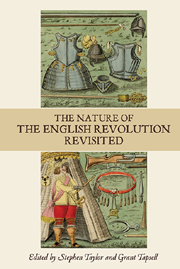Book contents
- Frontmatter
- Contents
- Preface and Acknowledgements
- List of contributors
- List of Abbreviations
- 1 Charles I and Public Opinion on the Eve of the English Civil War
- 2 Rethinking Moderation in the English Revolution: The Case of An Apologeticall Narration
- 3 The Parish and the Poor in the English Revolution
- 4 Body Politics in the English Revolution
- 5 The franchise Debate Revisited: The Levellers and the Army
- 6 Oliver Cromwell and the Instrument of government
- 7 ‘de te fabula narratur’: The Narrative Constitutionalism of James Harrington's Oceana
- 8 Democracy in 1659: Harrington and the Good Old Cause
- 9 The Restoration of the Church of England, 1660–1662: Ordination, Re-ordination and Conformity
- 10 Style, Wit and Religion in Restoration England
- 11 A British Patriarchy? Ecclesiastical Imperialism under the Later Stuarts
- Index
- Studies in Early Modern Cultural, Political and Social History
9 - The Restoration of the Church of England, 1660–1662: Ordination, Re-ordination and Conformity
Published online by Cambridge University Press: 05 July 2013
- Frontmatter
- Contents
- Preface and Acknowledgements
- List of contributors
- List of Abbreviations
- 1 Charles I and Public Opinion on the Eve of the English Civil War
- 2 Rethinking Moderation in the English Revolution: The Case of An Apologeticall Narration
- 3 The Parish and the Poor in the English Revolution
- 4 Body Politics in the English Revolution
- 5 The franchise Debate Revisited: The Levellers and the Army
- 6 Oliver Cromwell and the Instrument of government
- 7 ‘de te fabula narratur’: The Narrative Constitutionalism of James Harrington's Oceana
- 8 Democracy in 1659: Harrington and the Good Old Cause
- 9 The Restoration of the Church of England, 1660–1662: Ordination, Re-ordination and Conformity
- 10 Style, Wit and Religion in Restoration England
- 11 A British Patriarchy? Ecclesiastical Imperialism under the Later Stuarts
- Index
- Studies in Early Modern Cultural, Political and Social History
Summary
Modern accounts of the re-establishment of the Church of England in 1660-2 have usually focussed on the politics of court and parliament, on set pieces such as the Worcester House and Savoy conferences, and on the revival of cathedral communities and the machinery of diocesan government. Ordination, by contrast, has been largely neglected. Robert Bosher declared that it was ‘not a major issue’; other historians have noted that re-ordination, namely the requirement that presbyterians take episcopal orders to remain within the ministry, was highly contentious and that its inclusion in the Act of Uniformity of 1662 helped to swell the numbers ejected after St Bartholomew's day, but even this important point has not been systematically pursued. A thorough study of the number and pattern of ordinations in 1660-2, building on evidence in the Clergy of the Church of England Database, gives us a rather different view of the restoration of the Church in three important ways. First, this was an extraordinary and unsettled period. Very large numbers of candidates, among them many former presbyterians, obtained episcopal orders. These were dispensed by a minority of bishops, including several holding Scottish and Irish sees, with little regard for canonical regulations. The return of the customary administration of ordination only dates from the very end of 1662. Second, the fact that only a handful of bishops regularly conferred orders reveals starkly different practices of ordination among the episcopate and the paradox of high churchmen, such as Sheldon, leaving the restocking of the parish ministry to bishops who were more accommodating to tender puritan consciences.
- Type
- Chapter
- Information
- The Nature of the English Revolution Revisited , pp. 197 - 232Publisher: Boydell & BrewerPrint publication year: 2013



